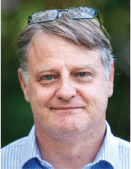Estimating porosity and permeability in the Springbok Sandstone, Surat Basin (Queensland), using new wireline log-based workflow
Kasia Sobczak A B , Heinz-Gerd Holl A and Andrew Garnett AA Centre for Natural Gas, The University of Queensland, Brisbane, Qld 4072, Australia.
B Corresponding author: Email: k.sobczak@uq.edu.au
The APPEA Journal 61(2) 720-725 https://doi.org/10.1071/AJ20201
Accepted: 12 February 2021 Published: 2 July 2021
Abstract
The Upper Jurassic Walloon Coal Measures of the Surat Basin (Queensland) host some of the most prominent coal seam gas (CSG) resources in Australia. The Walloon Coal Measures are directly overlain by the Springbok Sandstone formation, historically referred to as a regional aquifer. An increasing number of studies and industry models suggest relatively limited hydraulic connectivity within the formation and between it and the underlying coal measures, due to extreme lithological heterogeneity. Accurate evaluation of the permeability, as well as lateral and vertical continuity of the lithological units within the Springbok Sandstone, is critical in reservoir models that form the basis of reasonable aquifer protection practices and impact prediction. This study presents a wireline log-based workflow applied to identify permeable zones within the Springbok Sandstone in 31 CSG wells across the Surat Basin that allows robust estimations of porosities and Klinkenberg permeabilities. The workflow primarily utilises spontaneous potential, density, neutron and resistivity logs, and was developed by integrating current industry practices implemented by operators on a local scale to identify risk (permeable) zones in the vicinity of targeted coal seams. The results of this case study indicate that permeable zones within the interval are volumetrically minor (on average 25% N/G) and likely isolated, with Klinkenberg permeabilities rarely exceeding 10–20 mD. This evidence for low hydraulic connectivity, as well as significant local variations in the character of the Springbok Sandstone, suggests that the definition of the formation as a regional, continuous aquifer and the way it is modelled needs to be revised.
Keywords: coal seam gas, CSG, Surat Basin, Queensland, Springbok Sandstone, Walloon Coal Measures, permeability, porosity, wireline logging, Jurassic, aquifer.

Dr Kasia Sobczak is a Postdoctoral Research Fellow at the Centre for Natural Gas (the University of Queensland). As a sedimentary geologist, her current research focuses on coal seam gas exploration, improving well-to-well correlations and aquifer protection in the Surat Basin, Queensland, using wireline log interpretation, facies analysis, basin modelling and sedimentary provenance analysis. Dr Sobczak is also involved in a project seeking to assess the potential for CO2 injection and storage in Jurassic sedimentary formations of eastern Australia. Her other research interests and activities include stratigraphy, source-to-sink sediment transport processes, U-Pb detrital zircon and rutile dating, CA-TIMS dating, Ar–Ar thermochronology and sedimentary petrography. Dr Sobczak holds a PhD in geology from Queensland University of Technology, Australia. She is an active member of several professional societies, including the Geological Society of Australia and the Petroleum Exploration Society of Australia, and throughout her career, has undertaken various professional and volunteering science communication roles. |

Dr Heinz-Gerd Holl is a Geologist with the Centre for Natural Gas at the University of Queensland. He joined the Centre in 2015 working on plug and abandonment technologies and is now a member of a research team aiming to improve characterisation of the Walloon Coal Measures-Springbok transition in the Surat Basin. From 2010 to 2015, he was a lead geologist with Geodynamics Limited, responsible for international geothermal exploration and the Habanero geothermal project in the Cooper Basin. He worked for Schlumberger Carbon services as Senior CO2 Storage Geologist from 2007 to 2010, leading sedimentary basin screening and site characterisation projects in Australia, New Zealand, the Netherlands and Germany. Before this appointment, he worked for 5 years at the GFZ German Research Centre for Geosciences in Potsdam, Germany, as a geothermal project manager and senior geothermal geologist and as a lecturer/researcher at the Technical University of Berlin/Institute of Applied Geosciences. Dr Holl holds a PhD in Geology of the University of Bonn and is a member of the EAGE, SPE and GRC. |

Prof. Andrew Garnett is the Director of the Centre for Natural Gas at the University of Queensland, leading large multidisciplinary research programs contributing to future energy transitions through natural gas and carbon abatement. A former Shell and Schlumberger executive, Prof. Garnett has over 25 years of world-wide experience with oil majors in conventional and unconventional hydrocarbon exploration, appraisal and development projects. Before joining the University of Queensland, Prof. Garnett consulted widely on unconventional gas developments, most notably those seeking to reduce high greenhouse gas emissions. He was a CEO and Project Director of the ZeroGen IGCC & CCS Project, and in addition to his current UQ role is non-Executive Director of the Australian Gas Industry Trust and a reviewer for the International Energy Agency World Energy Outlook series and recently completed his appointment and a non-Executive Director with NERA. |
References
Baublys, K. A., Hamilton, S. K., Golding, S. D., Vink, S., and Esterle, J. (2015). Microbial controls on the origin and evolution of coal seam gases and production waters of the Walloon Subgroup; Surat Basin, Australia. International Journal of Coal Geology 147, 85–104.| Microbial controls on the origin and evolution of coal seam gases and production waters of the Walloon Subgroup; Surat Basin, Australia.Crossref | GoogleScholarGoogle Scholar |
Bianchi, V., Esterle, J., and Salles, T. (2015). The stratigraphic forward modelling for investigating hidden reservoir geometries and connectivity: Springbok formation (Surat Basin, Queensland). In ‘Proceedings of the AAPG International Conference and Exhibition, Melbourne, 13–16 September 2015’.
Exon, N. F. (1976). Geology of the Surat Basin in Queensland. Bureau of Mineral Resources, Geology, and Geophysics Bulletin 166, .
Gaede, O., and Levy, M. (2018). Targeting core sampling with machine learning: case study from the Springbok Sandstone formation, Surat Basin. ASEG Extended Abstracts 2018, 1–7.
| Targeting core sampling with machine learning: case study from the Springbok Sandstone formation, Surat Basin.Crossref | GoogleScholarGoogle Scholar |
Gaede, O., Levy, M., Murphy, D. T., Jenkinson, L., and Flottmann, T. (2020). Well-log-constrained porosity and permeability distribution in the Springbok Sandstone formation, Surat Basin, Australia. Hydrogeology Journal 28, 103–124.
Green, P. M., Carmichael, D. C., Brain, T. J., Murray, C. G., McKellar, J. L., Beeston, J. W., and Gray, A. R. G. (1997). Lithostratigraphic units in the Bowen and Surat basins, Queensland. In ‘The Surat and Bowen Basins, South-east Queensland’. (Ed. P. M. Green.) pp. 41–108. (Minerals and Energy Review Series, Queensland Department of Mines and Energy.)
Hawlader, H. M. (1989). Petrology, diagenesis, and reservoir potential of the Surat Basin Sandstones with special reference to hydrocarbon exploration. PhD Thesis, Macquarie University, Sydney.
Kieft, R., Guiton, S., Churchill, J., and Webber, R. (2015). Sedimentological and hydrostratigraphical characterisation of the Springbok Sandstone formation. In ‘Proceedings of the AAPG Asia Pacific Geoscience Technology Workshop,12–13 February 2015, Brisbane’. Available at http://www.searchanddiscovery.com/pdfz/abstracts/pdf/2015/90234gtw/abstracts/ndx_kieft.pdf.html
Levy, M., and Gaede, O. (2018). Identification of clay minerals within the Springbok formation, Surat Basin. ASEG Extended Abstracts 2018, 1–8.
OGIA (2012). Underground water impact report for the Surat Cumulative Management Area. Queensland, Australia, Office of Groundwater Impact Assessment, Department of Natural Resources, Mines and Energy.
OGIA (2016). Underground water impact report for the Surat Cumulative Management Area. Queensland, Australia, Office of Groundwater Impact Assessment, Department of Natural Resources, Mines and Energy.
OGIA (2019). Underground water impact report for the Surat Cumulative Management Area. Queensland, Australia, Office of Groundwater Impact Assessment, Department of Natural Resources, Mines and Energy.
Power, P. E., and Devine, S. B. (1968). Some sediments of the Jurassic stratigraphic nomenclature in the Great Artesian Basin. Queensland Government Mining Journal 69, 194–198.
Ransley, T., Radke, B. M., Feitz, A. J., Kellett, J. R., Owens, R., Bell, J., Stewart, G., and Carey, H. (2015). ‘Hydrogeological Atlas of the Great Artesian Basin’. (Geoscience Australia: Canberra.)
Reilly, M., Hurter, S., Hamerli, Z., de Andrade Vieira Filho, C. L., LaCroix, A., and Gonzalez, S. (2019). An integrated approach to the Surat Basin stratigraphy. The APPEA Journal 59, 940–945.
| An integrated approach to the Surat Basin stratigraphy.Crossref | GoogleScholarGoogle Scholar |
Schlumberger Ltd. (2016). Techlog Version 2016.2 [computer software].
Scott, S., Anderson, B., Crosdale, P., Dingwall, J., and Leblang, G. (2007). Coal petrology and coal seam gas contents of the Walloon Subgroup—Surat Basin, Queensland, Australia. International Journal of Coal Geology 70, 209–222.
Towler, B., Firouzi, M., Underschultz, J., Rifkin, W., Garnett, A., Schultz, H., Esterle, J., Tyson, S., and Witt, K. (2016). An overview of the coal seam gas developments in Queensland. Journal of Natural Gas Science and Engineering 31, 249–271.
| An overview of the coal seam gas developments in Queensland.Crossref | GoogleScholarGoogle Scholar |
Wainman, C. C., and McCabe, P. J. (2019). Evolution of the depositional environments of the Jurassic Walloon Coal Measures, Surat Basin, Queensland, Australia. Sedimentology 66, 1673–1699.
| Evolution of the depositional environments of the Jurassic Walloon Coal Measures, Surat Basin, Queensland, Australia.Crossref | GoogleScholarGoogle Scholar |


